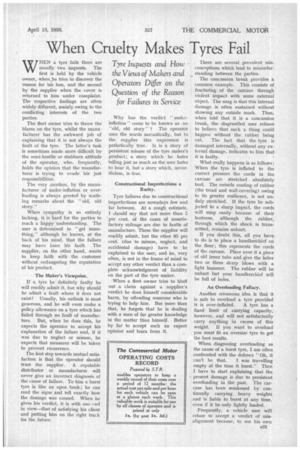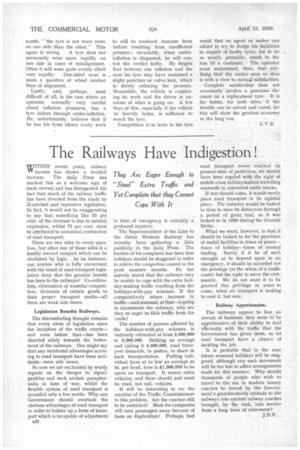When Cruelty Makes Tyres Fail W HEN a tyre fails there
Page 31

Page 32

If you've noticed an error in this article please click here to report it so we can fix it.
are usually two inquests. The first is held by the vehicle owner, when he tries to discover the reason for his loss, and the second by the supplier when the cover is returned to him under complaint. The respective findings are often widely different, mainly owing to the conflicting interests of the two parties.
The fleet owner tries to throw the blame on the tyre, whilst the manufacturer has the awkward job of explaining that it is not always the fault of the tyre. The latter's task is sometimes made more difficult by the semi-hostile or stubborn attitude of the operator, who, frequently, holds the opinion that the manufacturer is trying to evade his just responsibilities.
The very mention, by the manufacturer of under-inflation or overloading is always greeted by scathing remarks about the "old, old story."
When sympathy is so entirely lacking, it is hard for the parties to reach a happy understanding. The user is determined to "get something," although he knows, at the back of -his mind, that the failure may have been his fault. The supplier, on the other hand, wants to keep faith with the customer without endangering the reputation of his product.
The Maker's Viewpoint.
If a tyre be definitely faulty he will readily admit it, but why should he admit a fault where it does not exist? Usually, his outlook is most generous, and he will even make a policy allowance on a tyre which has failed through no fault of manufacture. But, when he does this, he expects the operator to accept his explanation of the failure and, if it was due to neglect or misuse, he expects that measures will be taken to prevent recurrence.
The first step towards mutual satisfaction is that the operator should trust the supplier. A reputable distributor or manufacturer will never give an incorrect diagnosis of the cause of failure. To him a burst tyre is like an open book ; he can read the signs and tell exactly how the damage was caused. When he gives his verdict, it is with one end in view—that of satisfying his client and putting him on the right track for the future. Why has the verdict " tinderinflation " come to be known as me "Old, old story " ? The operator uses the words sarcastically, but to the supplier this expression is pathetically true. It is a story of persistent misuse of the tyre maker's product; a story which he hates telling just as much as the user hates to hear it, but a story which, nevertheless, is true.
Constructional Imperfections a Rarity.
Tyre failures due to constructional imperfections are nowadays few and far between. At a rough estimate, I should say that not more than 5 per cent. of the cases of unsatisfactory mileage are due to faults of manufacture. These the supplier will readily admit, but the other 95 per cent. (due to misuse, neglect, and aceidental damage) have to be explained to the user, and he, very often, is not in the frame of mind to accept any other verdict than a complete acknowledgment of liability on the part of the tyre maker.
When a fleet owner tries to bluff out a claim against a supplier's verdict he does himself considerable harm, by offending someone who is trying to help him. But more than that, he forgets that he is dealing with a man of far greater knowledge in the matter than himself. Better by far to accept such an expert opinion and learn from it. There are several prevalent misconceptions which lead to misunderstanding between the parties.
The concussion break provides a common example. This consists of fracturing of the carcase through violent impact with some external object. The snag is that this internal damage is often sustained without showing any outside mark. Thus, when told that it is a concussion break, the disgruntled user refuses to believe that such a thing could happen without the rubber being cut. The fact that the tyre is damaged internally, without any external damage, indicates to him that it is faulty.
What really happens is as follows: When the tyre is inflated to the correct pressure the cords in the carcase are stretched absolutely taut. The outside coating of rubber (the tread and wall-covering) owing to its greater resilience, is not unduly stretched. If the tyre be subjected to a sharp impact, the cords will snap easily because of their tautness, although the rubber, through which the shock is transmitted, remains unhurt.
If you doubt this, all you have to do is to place a handkerchief on the floor ; this represents the cords of the carcase. Place over it a piece of old inner tube and give the latter two or three sharp blows with a light hammer. The rubber will be unhurt but your handkerchief will be full of holes.
An Overloading Fallacy. Another erroneous idea is that it is safe to overload a tyre provided
it is over-inflated. A tyre has a fixed limit of carrying capacity, however, and will not satisfactorily carry anything in excess of this weight. If you want to overload you must fit an oversize tyre to get the best results.
When diagnosing overloading as the cause of a burst tyre, I am often confronted with the defence "Oh, it I was travelling
can't be that.
empty at the time it burst." Then I have to start explaining that the s present damage is due to persistent overloading in the past. The carcase has been weakened by continually carrying heavy weights and is liable to burst at any time, even if it be only lightly loaded. Frequently, a vehicle user will refuse to accept a verdict of misalignment because, to use his own a21 words, " the tyre is not worn more on one side than the other." This again is wrong. A tyre does not necessarily wear more rapidly on one side in cases of misalignment. Often it will wear quite evenly albeit very rapidly. One-sided wear is more a question of wheel camber than of alignment.
Lastly, and, perhaps, most difficult of all, is the case where an operator, normally very careful about inflation pressures, has a tyre failure through under-inflation. He, unfortunately, believes that if he has his tyres blown every week he will be rendered immune from failure resulting from insufficient pressure ; invariably, when underinflation is diagnosed, he will contest the verdict hotly. He forgets that between one inflation and the next his tyre may have sustained a slight puncture or valve leak, which is slowly reducing the pressure. Meanwhile, the vehicle is continuing its work and the driver is unaware of what is going on. A _few days of this, especially if the vehicle be heavily laden, is sufficient to. wreck the tyre.
Competition is so keen in the tyre
world that no agent or maker can afford to try, to dodge his liabilities in respeCt of faulty tyres, for to do so would, probably, result in the loss of a customer. The operator must understand, then, that anything that the maker says or -does is with a view to mutual saiisfaction.
Complete satisfaction does not necessarily involve a generous discount on a replacement tyre. It is far better, for both sides, if the trouble can be solved and cured, for this willshow the greatest economy in the long run.
L.V.B.




















































































